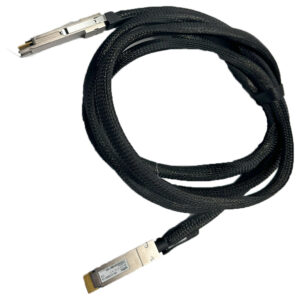Passive Direct Attach Copper (DAC) cables are a perfect solution for ultrashort network connections when low latency and almost zero power consumption are priorities.
Cloud service providers (CSPs), telecoms and other hyper-scale data centers are in continuous search of robust physical connections that:
- save utility costs by using no power and reducing heat
- increase speed with an equipment upgrade plan
- reduce maintenance/troubleshooting costs
- eliminate downtime
As a result, Direct Attach Copper (DAC) cables are becoming more common—and important—in data center design and planning. DACs provide reliable, cool and affordable data transmission at short distances with the highest available bandwidth.
To help you understand how DAC cables and DAC breakout cables benefit your site, we’ve listed ten benefits that direct attach copper cables may be the perfect solution for your data center, high-performance computer or large-capacity storage facility.
Benefits of DAC cables and DAC breakout cables
- Low latency: Direct attach copper cables have the lowest latency of all short-reach cables (<8ft /3m). For services such as financial trading, edge computing, AI, AR/VR gaming, enterprise video conferencing and time-sensitive online gambling, any reduction in latency is an edge.
- DACs are copper wire so there are no delays (as you’d find in AOCs) in switching copper signals to optical and then back to copper.
- DACs do not need Forward Error Correction (FEC) functions to be enabled, reducing latency issues even more.
- High speed at short distances: With a maximum reach of 3m at 400Gbps data rates, DACs are ideal for short interconnections. Applications for a data center include between servers in a rack, between a router in a switch in a rack, or between switches in a cluster.
- Durable: Copper cable is less fragile, less breakable than optical fibers. And, because it’s seamless with fewer components, it’s less susceptible to dust and the environment.
- Plug and play: Connect equipment from different OEMs with multi-vendor ends to ensure compatibility.
- Flexible: What configuration do you need to connect intra-rack switches and servers? DACs are available as either straight cables or breakout cables with options of 400G to 4×100, or 2×200, or 8×50. 100G to 4x25G, etc.
- Allows for high density switches: For anyone upgrading top-of-rack (ToR) switches to 100G, 200G or 400G and increasing port density, one breakout DAC cable can connect a single high-speed switch to 2,4 or 8 servers.
- Lower purchase cost: At its most basic level, copper cable is (far) cheaper than the same-sized fiber optic cable and can significantly reduce the cabling cost of an entire data center.
- Substantial utility savings: DACs do not require signal conditioning or a power supply so therefore do not consume electricity and generate minimal heat. These inherent properties can reduce data center operating expenses by eliminating thousands of kilowatts of electrical power. (Especially if DACs replace hundreds (or thousand?) of AOC optical cables already in place.)
- Reliable: The mean time between failures (MTBF) of passive copper cables is approximately 500 million hours – higher than the industry standard for optical cables.
- Wider temperature range: If your data center is heating up, 400G DAC cables perform better at higher temperature ranges than AOCs.
Common Passive DAC Cables
| Type | Reach | Cost | Min. Bend Radius | Max. Latency | Power Consumption | AWG |
|---|---|---|---|---|---|---|
| 10G SFP+ | 0.5-10m | $ | 21-30mm | 4.7 ns/m | <0.5W | 30-24 1 |
| 25G SFP28 | 0.5-5m | $ | 22.5-26mm | 4.5 ns/m | <0.15W | 30-24 1 |
| 40G QSFP+ | 0.5-5m | $ | 35-47.5mm | 5.2 ns/m | <0.15W | 30-24 1 |
| 100G QSFP28 DAC | 0.5-5m | $ | 35-40mm | 5.2 ns/m | <0.5W | 30-26 1 |
| 200G QSFP56 | 0.5-3m | $ | 35-40mm | 5.2 ns/m | <0.5W | 30-26 1 |
| 200G QSFP-DD | 0.5-3m | $$ | 35-40mm | 5.2 ns/m | <0.5W | 30-26 1 |
| 400G QSFP-DD | 0.5-3m | $$ | ~30mm | 5.2 ns/m | <0.1W | 26-30 1 |
Common Passive DAC Breakout Cables
| Type | Reach | Cost | Min. Bend Radius | Max. Latency | Power Consumption | AWG |
|---|---|---|---|---|---|---|
| 40G QSFP+ to 10G SFP+ | 0.5-5m | $ | 35-52mm 1 | 5.2 ns/m | <0.5W | 30-26 2 |
| 100G QSFP28 to 4x 25G SFP28 | 0.5-5m | $ | 45-52mm 1 | 5.2 ns/m | <0.5W | 30-26 2 |
| 200G QSFP56 to 4x 50G SFP56 | 0.5-3m | $ | 42-57mm 1 | 5.2 ns/m | <0.5W | 30-26 2 |
| 200G QSFP-DD to 2x 100G QSFP28 | 0.5-3m | $ | 42-57mm 1 | 5.2 ns/m | <0.5W | 30-26 2 |
| 400G QSFP-DD to 4x 100G QSFP56 | 1-3m | $ | 42-57mm 1 | 5.2 ns/m | <0.5W | 30-27 2 |
2. Less at longer lengths
Conclusion: To DAC or not to DAC?
DAC cabling and DAC breakout cabling can provide the most robust, cost-effective connectivity from switches to servers at any desired data rate. The limitations of DACs are minimal but unchangeable:
- DAC cabling is heavier and bulkier than AOCs
- DAC cabling is susceptible to electromagnetic interference (EMI)
- DAC cables are for shorter distances only
If you’re looking for a potential DAC solution to solve network latency, utility costs or density issues, let Vitex help. We have 20 years of developing and sourcing the right fiber optic and cabling solutions for OEMs, end users, system integrators and network specialists. Contact us to speak to an engineer about your application or to order a sample product for onsite testing.
Related Products


